Structural Failure and Mechanical Response of Buried Pipelines Under Offshore Fault Dislocation
Abstract
1. Introduction
2. Mechanical Analysis of Pipe Buckling
3. Three-Dimensional Numerical Pipeline–Soil Interaction Model
3.1. FE Model
3.2. Material Properties
3.3. Soil–Pipe Interaction and Boundary Conditions
3.4. Imposition of Boundary Equivalent Springs
3.5. Computational Simulation Steps
3.6. Validation of the FE Model
4. Analysis of Numerical Simulation Results
4.1. The Effect of Fault Displacement on the Mechanical Response of Pipelines
- I.
- In the early stage of fault misalignment (small Δd), the pipeline remains in the elastic response range with no significant structural deformation. As fault displacement has not reached the pipe’s core, bending moment rapidly accumulates and peaks near the fault, reflecting structural constraints reinforcing local bending. Axial force increases slightly with misalignment, indicating the pipe’s overall axial stress state. At this stage, strain distribution is uniform, structural stiffness remains intact, and the pipeline maintains overall continuity and stability.
- II.
- With increasing fault misalignment, the bending moment gradually decreases, indicating yielding near the fault and the formation of a plastic hinge. Local structural stiffness decreases, and bending capacity weakens progressively. Simultaneously, axial force increases slowly, indicating gradual intensification of axial tensile and compressive effects. Strain response becomes asymmetric, with increasing deformation difference between tensile and compressive sides. Plastic strain concentrates locally, indicating the onset of nonlinear structural evolution.
- III.
- During the pipeline’s plastic development stage, fault misalignment is pronounced, causing widespread plastic deformation. The bending moment stabilizes at a low level, indicating that the structure’s deformation capacity has reached saturation. Axial force plateaus or increases slightly, reflecting the tensile and compressive loads nearing their limits. Strain grows rapidly, especially in the tensile region of the large-strain zone, as structural ductility gradually exhausts, creating a latent risk of fracture. At this stage, the pipeline approaches a strongly nonlinear response.
- IV.
- When fault misalignment reaches a critical value, the pipe’s local structure fails completely, resulting in rupture or fracture. At this stage, the bending moment rapidly decays to near zero, as the fractured section can no longer transfer bending stiffness. Axial force also drops sharply due to structural fracture, interrupting the mechanical load path and preventing axial load transfer. Strain exhibits a sudden drop or release after reaching its peak, marking structural instability and failure. This phase represents the final transition from “deformation” to “damage” of the pipeline caused by the fault.
4.2. Effect of Pipe Diameter-to-Thickness Ratio
4.3. Effect of Internal Pipe Pressure
5. Conclusions
- (1)
- Under fault misalignment, the mechanical response of buried pipelines can be divided into four distinct stages: In the initial stage, elastic deformation dominates, the pipeline structure remains stable, and the bending moment rises rapidly. As misalignment increases, the yielding stage begins, characterized by the formation of local plastic hinges, a decrease in bending moment, and continued growth of axial force and strain. Next, in the plastic development stage, structural stiffness significantly degrades, the bending moment stabilizes, and strain rapidly approaches the limit state. Finally, when misalignment reaches a critical value, structural rupture occurs, causing a rapid decline in bending moment and axial force, strain fluctuations, and a complete loss of the pipe’s load-bearing capacity.
- (2)
- The diameter-to-thickness ratio is a key parameter influencing the structural stiffness and misalignment resistance of the pipeline. As the diameter-to-thickness ratio increases, the relative wall thickness decreases, leading to reduced overall stiffness and diminished ability to resist shear deformation caused by fault misalignment. This often results in deformation concentration, local failure, and an expanded damage range. Conversely, reducing the diameter-to-thickness ratio (i.e., increasing wall thickness) significantly enhances the pipe’s axial and bending stiffness, improves deformation coordination within the fault zone, effectively inhibits plastic deformation and destabilization, and thus improves structural deformation resistance and stability. Therefore, reasonable control of the diameter-to-thickness ratio is an important design strategy for enhancing pipeline resilience against fault misalignment. However, excessively thick walls substantially increase construction and material costs, requiring a balance between structural performance and economic considerations to optimize safety and cost efficiency.
- (3)
- The internal pressure of the pipeline exerts a significant dual effect on its structural response under fault misalignment. On one hand, internal pressure enhances the radial stiffness and axial stability of the pipeline, particularly under large fault displacements, helping to inhibit overall collapse, delay structural buckling, and improve deformation resistance and mechanical stability. On the other hand, increased internal pressure alters the pipeline’s stress boundary conditions, inducing circumferential tensile stress concentration, which raises the risk of localized bulging and buckling—especially in deformation concentration zones that are more sensitive. When fault misalignment is small, internal pressure may exacerbate stress redistribution and local deformation, making the pipe more susceptible to local instability. According to the buckling theory of thin-walled round pipes, although internal pressure can enhance initial structural stiffness, the circumferential tensile stress it induces may trigger local buckling.
Author Contributions
Funding
Data Availability Statement
Conflicts of Interest
References
- Datta, S.; Sarkar, S. A review on different pipeline fault detection methods. J. Loss Prev. Process Ind. 2016, 41, 97–106. [Google Scholar] [CrossRef]
- Takada, S.; Hassani, N.; Fukuda, K. A new proposal for simplified design of buried steel pipes crossing active faults. Earthq. Eng. Struct. Dyn. 2001, 30, 1243–1257. [Google Scholar] [CrossRef]
- Ni, P.; Moore, I.D.; Take, W.A. Numerical modeling of normal fault-pipeline interaction and comparison with centrifuge tests. Soil Dyn. Earthq. Eng. 2018, 105, 127–138. [Google Scholar] [CrossRef]
- Li, H.; Feng, X.; Zhao, L. Failure analysis of a buried large-diameter prestressed concrete cylinder pipeline subjected to strike-slip fault displacement. Tunn. Undergr. Space Technol. 2022, 121, 104334. [Google Scholar] [CrossRef]
- Eidinger, J.; De Castro, L.; Ma, D. The 1906 earthquake impacts on the San Francisco and Santa Clara water systems—What we learned, and what we are doing about it. Earthq. Spectra 2006, 22 (Suppl. S2), 113–134. [Google Scholar] [CrossRef]
- Tsai, J.S.; Jou, L.D.; Lin, S.H. Damage to buried water supply pipelines in the chichi (Taiwan) earthquake and apreliminary evaluation of seismic resistance of pipe joints. J. Chin. Inst. Eng. 2000, 23, 395–408. [Google Scholar] [CrossRef]
- Asgarihajifirouz, M.; Dong, X.; Shiri, H. A Decoupled Buckling Failure Analysis of Buried Steel Pipeline Subjected to the Strike-Slip Fault. J. Mar. Sci. Eng. 2024, 12, 1243. [Google Scholar] [CrossRef]
- Melissianos, V.E. Onshore buried steel fuel pipelines at fault crossings: A review of critical analysis and design aspects. J. Pipel. Syst. Eng. Pract. 2022, 13, 03122002. [Google Scholar] [CrossRef]
- Li, Z.; Yu, Y.; Liu, X.; Liu, X.; Wang, X.; Xu, L.; Yu, J. Propagation and arrest of collapse failures in a buried offshore pipeline crossing reverse fault areas. Mar. Struct. 2024, 93, 103522. [Google Scholar] [CrossRef]
- Karamitros, D.K.; Bouckovalas, G.D.; Kouretzis, G.P.; Gkesouli, V. An analytical method for strength verification of buried steel pipelines at normal fault crossings. Soil Dyn. Earthq. Eng. 2011, 31, 1452–1464. [Google Scholar] [CrossRef]
- Valsamis, A.I.; Bouckovalas, G.D.; Gantes, C.J. Alternative design of buried pipelines at active fault crossings using flexible joints. Int. J. Press. Vessel. Pip. 2020, 180, 104038. [Google Scholar] [CrossRef]
- Hu, Z.; Ren, X.; Wang, Q.; Wang, R.; Pan, R. Analytical method for the mechanical response of buried pipeline under the action of strike-slip faulting. Undergr. Space. 2022, 7, 268–277. [Google Scholar] [CrossRef]
- Zhang, Z.; Feng, J.; Zhu, Z.; Zhao, Q.; Pan, Y. Analytical solution for buried pipeline deformation induced by normal and reverse fault considering structural joint influence. Int. J. Numer. Anal. Methods Geomech. 2024, 48, 2085–2127. [Google Scholar] [CrossRef]
- Meniconi, S.; Brunone, B.; Tirello, L.; Rubin, A.; Cifrodelli, M.; Capponi, C. Transient tests for checking the Trieste subsea pipeline: Towards the field tests. J. Mar. Sci. Eng. 2024, 12, 374. [Google Scholar] [CrossRef]
- Demirci, H.E.; Bhattacharya, S.; Karamitros, D.; Alexander, N. Experimental and numerical modelling of buried pipelines crossing reverse faults. Soil Dyn. Earthq. Eng. 2018, 114, 198–214. [Google Scholar] [CrossRef]
- Abdoun, T.H.; Ha, D.; O’Rourke, M.J.; Symans, M.D.; O’Rourke, T.D.; Palmer, M.C.; Stewart, H.E. Factors influencing the behavior of buried pipelines subjected to earthquake faulting. Soil Dyn. Earthq. Eng. 2009, 29, 415–427. [Google Scholar] [CrossRef]
- Oskouei, A.V.; Tamjidi, A.; Pourshabani, P. Effects of burial depth in the behavior of buried steel pipelines subjected to strike-slip fault. Soil Dyn. Earthq. Eng. 2019, 123, 252–264. [Google Scholar] [CrossRef]
- Joshi, S.; Prashant, A.; Deb, A.; Jain, S.K. Analysis of buried pipelines subjected to reverse fault motion. Soil Dyn. Earthq. Eng. 2011, 31, 930–940. [Google Scholar] [CrossRef]
- Liu, W.; Guo, Q.; Qiao, C.; Hou, W. Strain design method of buried pipeline crossing fault. Eng. Fail. Anal. 2019, 105, 659–671. [Google Scholar] [CrossRef]
- Rahman, M.A.; Taniyama, H. Analysis of a buried pipeline subjected to fault displacement: A DEM and FEM study. Soil Dyn. Earthq. Eng. 2015, 71, 49–62. [Google Scholar] [CrossRef]
- Vazouras, P.; Karamanos, S.A.; Dakoulas, P. Finite element analysis of buried steel pipelines under strike-slip fault displacements. Soil Dyn. Earthq. Eng. 2010, 30, 1361–1376. [Google Scholar] [CrossRef]
- Banushi, G.; Squeglia, N.; Thiele, K. Innovative analysis of a buried operating pipeline subjected to strike-slip fault movement. Soil Dyn. Earthq. Eng. 2018, 107, 234–249. [Google Scholar] [CrossRef]
- Talebi, F.; Kiyono, J. Introduction of the axial force terms to governing equation for buried pipeline subjected to strike-slip fault movements. Soil Dyn. Earthq. Eng. 2020, 133, 106125. [Google Scholar] [CrossRef]
- Li, Z.; Zhang, S.; Shen, M.; Shen, Q. In Study on shallow steel utility tunnels under strike-slip fault conditions: Analytical and numerical approaches. Structures 2025, 79, 109536. [Google Scholar] [CrossRef]
- Zhang, S.; Bu, R.; Zhang, Z.; Gao, L.; Li, Z. A systematic model for the mechanical behavior of thin-walled composite FGM pipelines subjected to strike-slip faults in geohazard area. Thin-Walled Struct. 2024, 202, 112135. [Google Scholar] [CrossRef]
- Sarvanis, G.C.; Karamanos, S.A. Analytical model for the strain analysis of continuous buried pipelines in geohazard areas. Eng. Struct. 2017, 152, 57–69. [Google Scholar] [CrossRef]
- Zheng, Y.; Wu, K.; Jiang, Y.; Chen, R.; Duan, J. Optimization and design of pre-reinforcement for a subsea tunnel crossing a fault fracture zone. Mar. Geores. Geotechnol. 2023, 41, 36–53. [Google Scholar] [CrossRef]
- Zhang, W.; Ayello, F.; Honegger, D.; Taciroglu, E.; Bozorgnia, Y. Comprehensive numerical analyses of the seismic performance of natural gas pipelines crossing earthquake faults. Earthq. Spectra 2022, 38, 1661–1682. [Google Scholar] [CrossRef]
- Demirci, H.E.; Karaman, M.; Bhattacharya, S. Behaviour of buried continuous pipelines crossing strike-slip faults: Experimental and numerical study. J. Nat. Gas Sci. Eng. 2021, 92, 103980. [Google Scholar] [CrossRef]
- Liu, A.; Hu, Y.; Zhao, F.; Li, X.; Takada, S.; Zhao, L. An equivalent-boundary method for the shell analysis of buried pipelines under fault movement. Acta Seismol. Sinica. 2004, 17, 150–156. (In Chinese) [Google Scholar] [CrossRef]
- Kaya, E.S.; Uckan, E.; O’Rourke, M.J.; Karamanos, S.A.; Akbas, B.; Cakir, F.; Cheng, Y. Failure analysis of a welded steel pipe at Kullar fault crossing. Eng. Fail. Anal. 2017, 71, 43–62. [Google Scholar] [CrossRef]
- Ma, C.; Cheng, X.; Xu, T.; Xu, L.; Wang, Y.; An, K.; Hu, W. Research on local buckling failure range of X80 buried steel pipeline under oblique-reverse fault. Soil Dyn. Earthq. Eng. 2023, 164, 107592. [Google Scholar] [CrossRef]
- Liu, Q. Study on Seismic Surface Permanent Displacement of Active Faults. Recent Dev. World Seismol. 2014, 42–43. (In Chinese) [Google Scholar] [CrossRef]
- ASME B31.8; Gas Transmission and Distribution Piping Systems. American Society of Mechanical Engineers: New York, NY, USA, 2007.
- Banushi, G.; Squeglia, N. Seismic analysis of a buried operating steel pipeline with emphasis on the equivalent-boundary conditions. J. Pipel. Syst. Eng. Pract. 2018, 9, 04018005. [Google Scholar] [CrossRef]
- Rofooei, F.R.; Jalali, H.H.; Attari, N.K.A.; Kenarangi, H.; Samadian, M. Parametric study of buried steel and high density polyethylene gas pipelines due to oblique-reverse faulting. Can. J. Civ. Eng. 2015, 42, 178–189. [Google Scholar] [CrossRef]
- Zheng, Y.; Wu, K.; Wang, L.; Jiang, Y.; Liu, Y. Structural damage assessment and failure mode analysis for cross-fault submarine tunnels. Eng. Fail. Anal. 2024, 157, 107853. [Google Scholar] [CrossRef]
- Liao, P.; Guo, C.; Wang, F.; Sun, W.; Ni, P. Investigating brittle damage of buried pipelines under dip-slip faulting with peridynamics. Acta Geotech. 2023, 18, 1945–1965. [Google Scholar] [CrossRef]
- Zhang, R.; Wang, C.; Li, S.; Zhang, J.; Liu, W. Numerical simulation study on the performance of buried pipelines under the action of faults. Appl. Sci. 2023, 13, 11266. [Google Scholar] [CrossRef]
- Zhang, J.; Chen, Y.; Zhang, H. Local buckling evolution mechanism of a buried steel pipe under fault movements. Energy Sci. Eng. 2020, 8, 412–425. [Google Scholar] [CrossRef]
- Arumugam, T.; Vijaya Kumar, S.D.; Karuppanan, S.; Ovinis, M. The influence of axial compressive stress and internal pressure on a pipeline network: A review. Appl. Sci. 2023, 13, 3799. [Google Scholar] [CrossRef]
- Fang, P.; Xu, Y.; Gao, Y.; Ali, L.; Bai, Y. Mechanical responses of a fiberglass flexible pipe subject to tension & internal pressure. Thin-Walled Struct. 2022, 181, 110107. [Google Scholar] [CrossRef]
- Zeng, D.; Wang, X.; Ming, K.; Yu, C.; Zhang, Y.; Yu, Z.; Yan, J.; Li, F. Analysis and optimization design of internal pressure resistance of flexible composite pipe. Int. J. Press. Vessel. Pip. 2024, 210, 105271. [Google Scholar] [CrossRef]
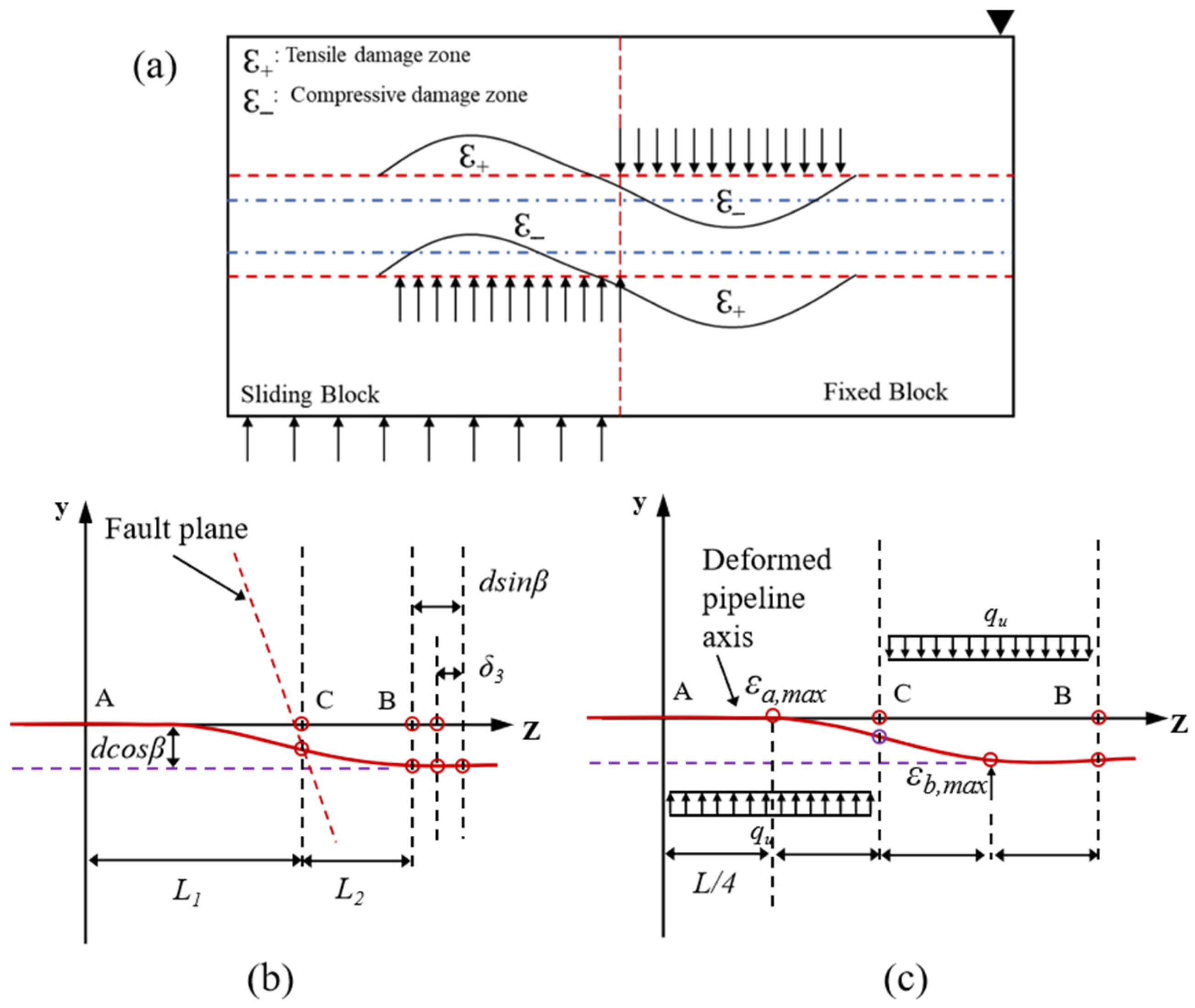





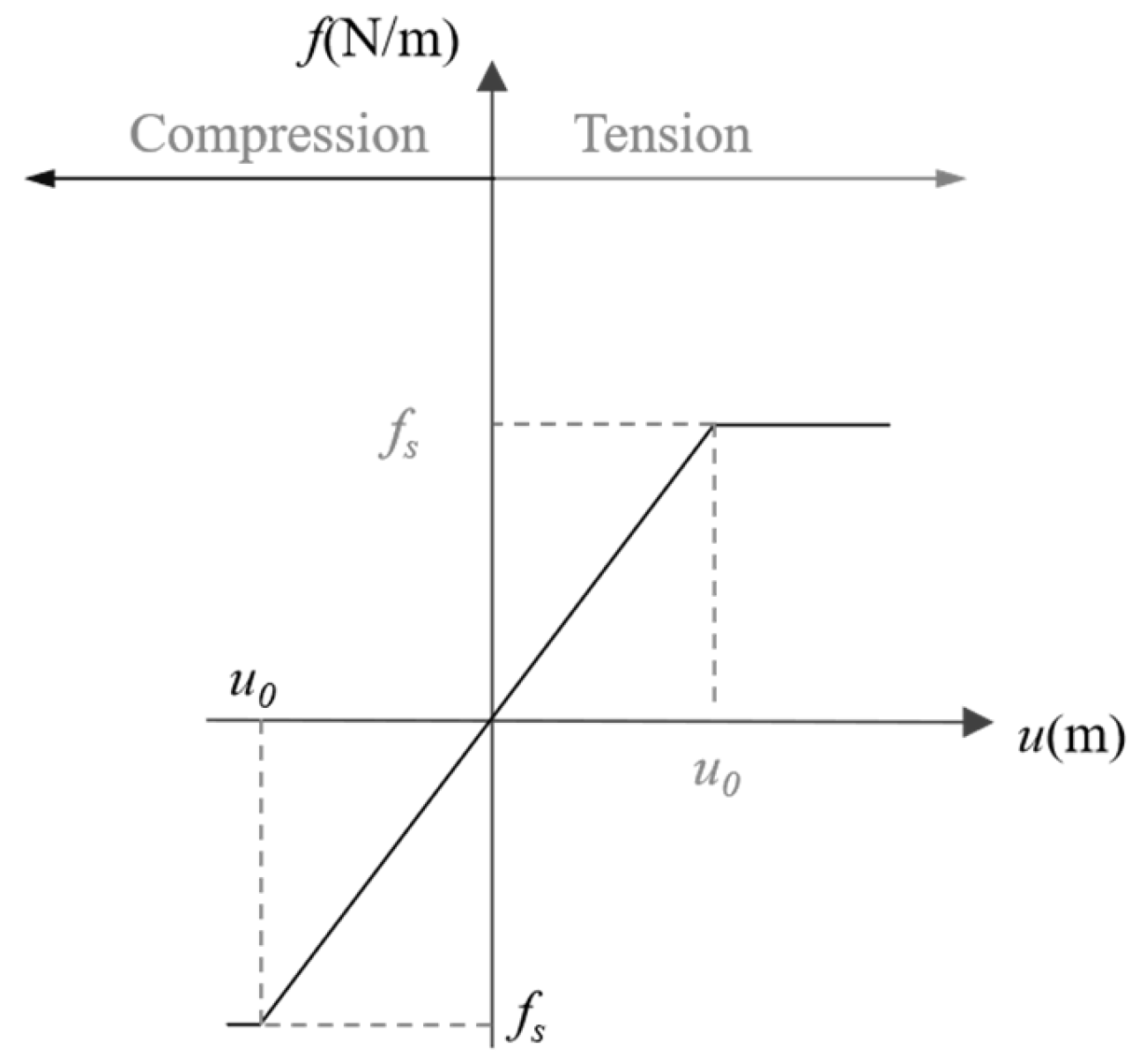


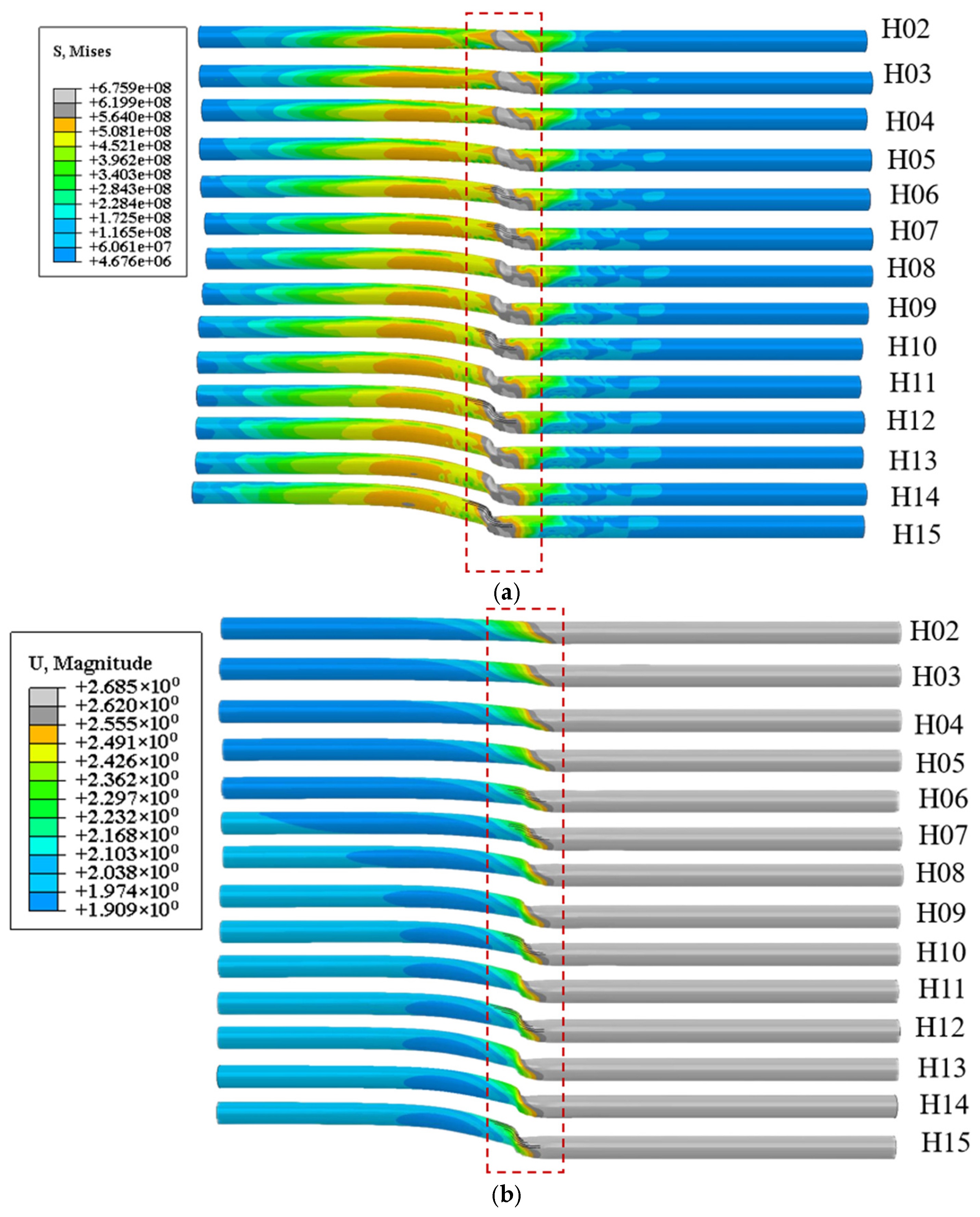
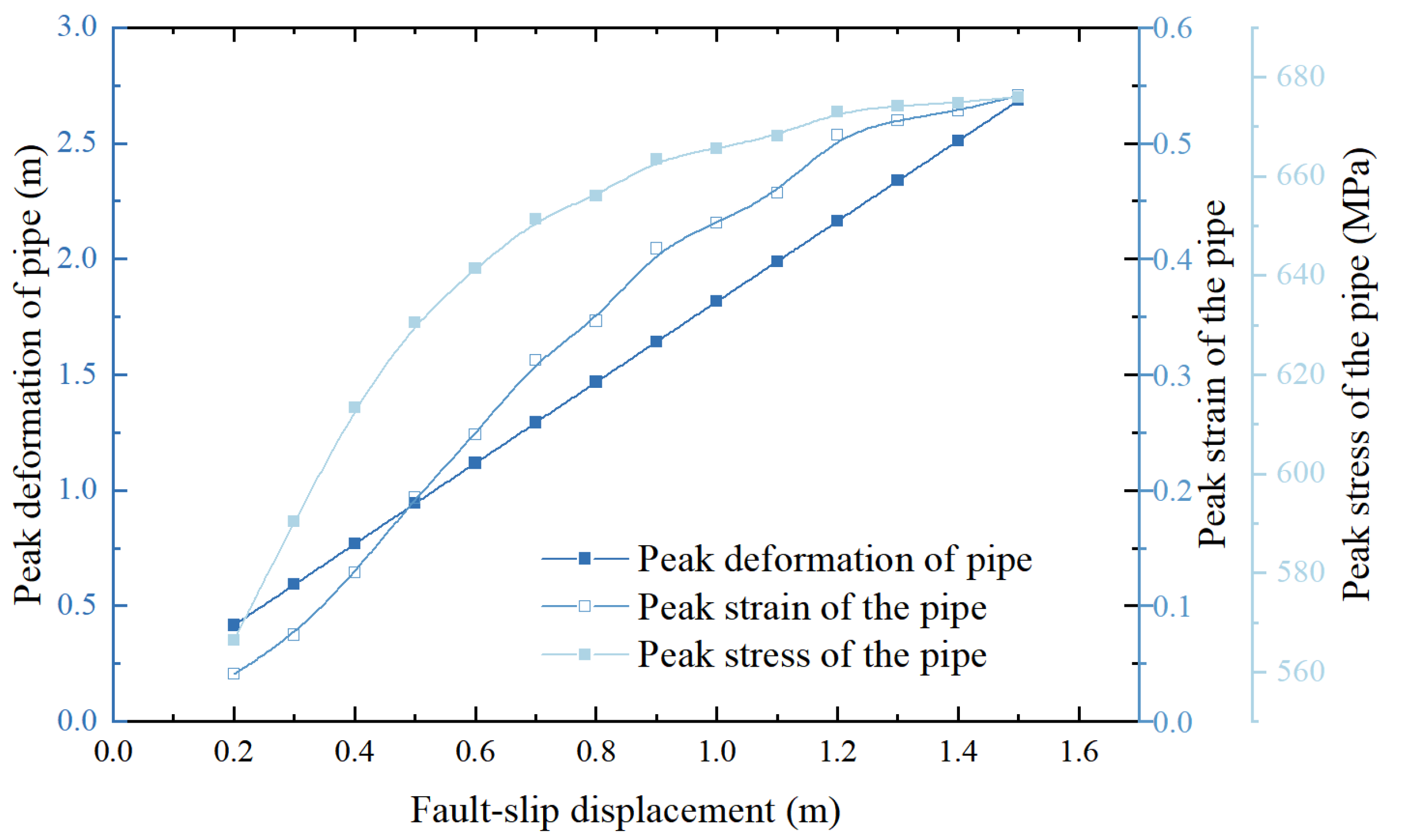

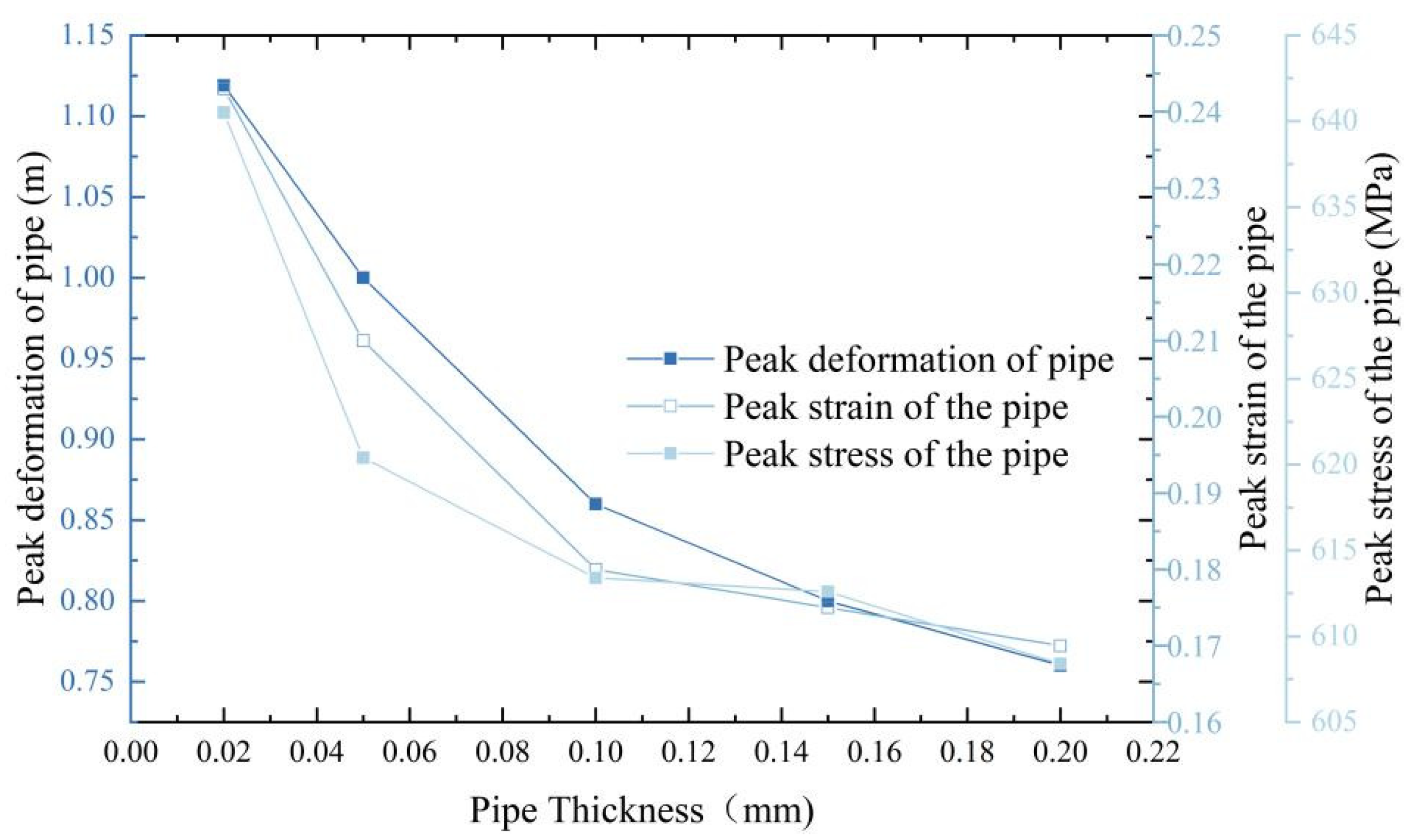
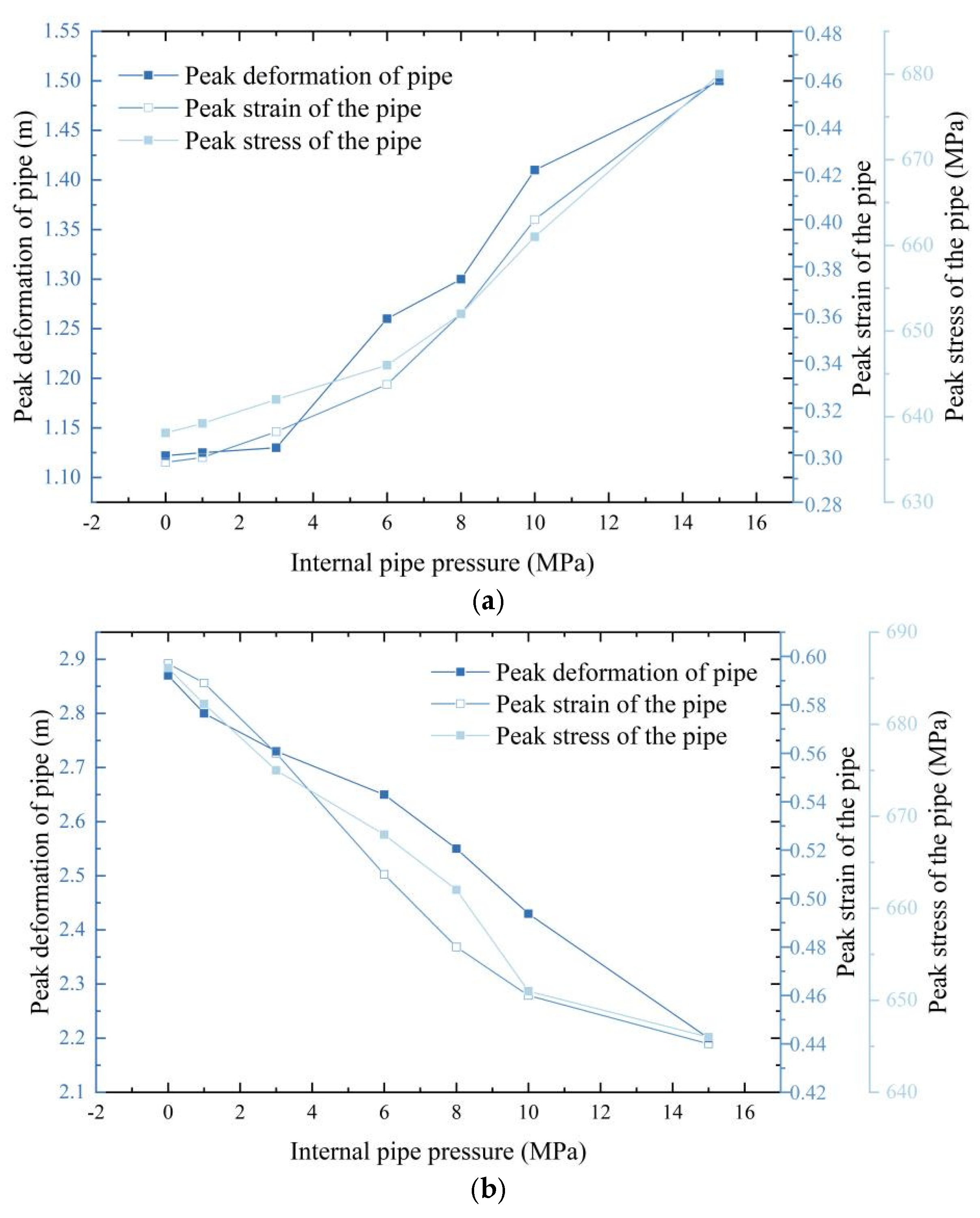

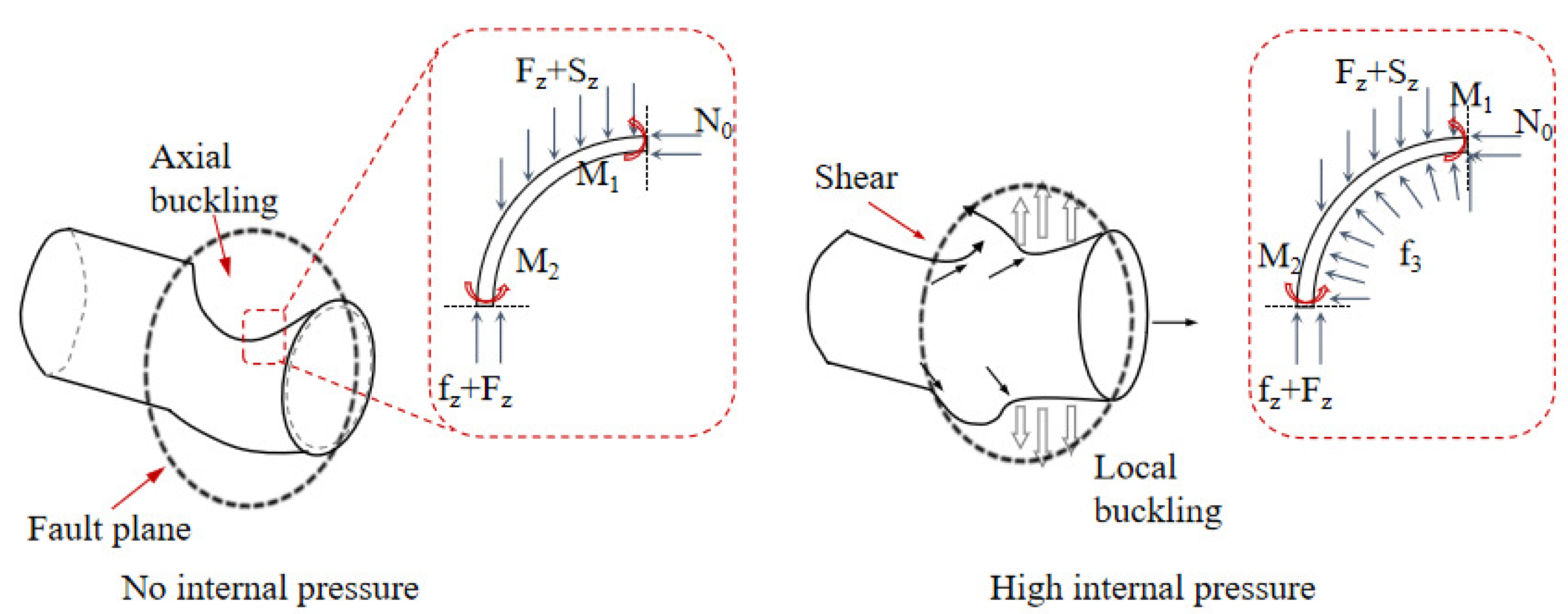
| Parameter Type | Density ρ (kg/m3) | Elastic Modulus E (MPa) | Poisson’s Ratio μ | Cohesion c (kPa) | Friction Angle φ (°) | Dilation Angle Ψ |
|---|---|---|---|---|---|---|
| Soil | 1900 | 40 | 0.35 | 40 | 22 | 0.01 |
| Classification | Parameter Type | Parameter Value |
|---|---|---|
| Fault | Pipe-fault crossing angle | 50° |
| Dip angle | 75° | |
| Displacement | 0.4 m | |
| Pipeline | Material | API-5L Grade B |
| Yield stress | 241 MPa | |
| Elastic modulus | 2 × 105 MPa | |
| Poisson’s ratio | 0.3 | |
| Diameter | 114.3 mm | |
| Thickness | 8.6 mm | |
| Burial depth | 1.2 m | |
| Internal pressure | 413 kPa | |
| Soil | Type | Sandy soil |
| Model size | 1.7 m × 2.0 m × 8.5 m | |
| Density | 20.6 kg/m | |
| Elastic modulus | 33 MPa | |
| Poisson’s ratio | 0.3 | |
| Cohesion | 5 kPa | |
| Friction angle | 38° | |
| Dilation angle | 0° |
Disclaimer/Publisher’s Note: The statements, opinions and data contained in all publications are solely those of the individual author(s) and contributor(s) and not of MDPI and/or the editor(s). MDPI and/or the editor(s) disclaim responsibility for any injury to people or property resulting from any ideas, methods, instructions or products referred to in the content. |
© 2025 by the authors. Licensee MDPI, Basel, Switzerland. This article is an open access article distributed under the terms and conditions of the Creative Commons Attribution (CC BY) license (https://creativecommons.org/licenses/by/4.0/).
Share and Cite
Qiu, C.; Tian, S.; Wang, Y. Structural Failure and Mechanical Response of Buried Pipelines Under Offshore Fault Dislocation. Appl. Sci. 2025, 15, 9450. https://doi.org/10.3390/app15179450
Qiu C, Tian S, Wang Y. Structural Failure and Mechanical Response of Buried Pipelines Under Offshore Fault Dislocation. Applied Sciences. 2025; 15(17):9450. https://doi.org/10.3390/app15179450
Chicago/Turabian StyleQiu, Chengzhu, Shuai Tian, and Yujie Wang. 2025. "Structural Failure and Mechanical Response of Buried Pipelines Under Offshore Fault Dislocation" Applied Sciences 15, no. 17: 9450. https://doi.org/10.3390/app15179450
APA StyleQiu, C., Tian, S., & Wang, Y. (2025). Structural Failure and Mechanical Response of Buried Pipelines Under Offshore Fault Dislocation. Applied Sciences, 15(17), 9450. https://doi.org/10.3390/app15179450





